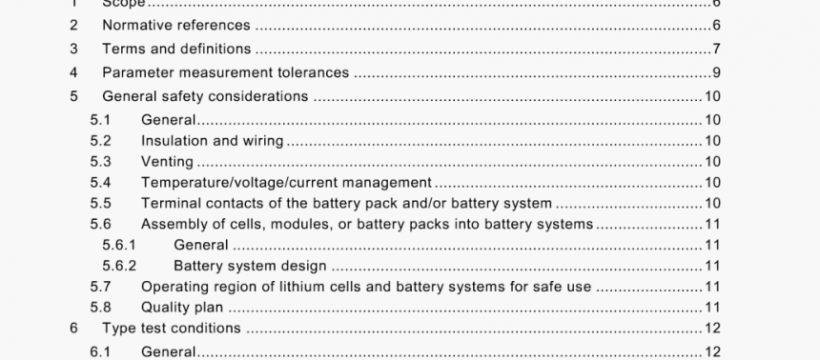IEC 62619:2017 pdf free download
IEC 62619:2017 pdf free download.Secondary cells and batteries containing alkaline or other non-acid electrolytes
7.2.2 Impact test (cell or cell block)
a) Requirements An impact to the cell as mentioned below shall not cause fire or explosion. b) Test The cell or cell block shall be discharged at a constant current of 0,2 1t A, to 50 % SOC. The cell or cell block is placed on a flat concrete or metal floor. A type 316 stainless steel bar with a diameter of 15,8 mm±0,1 mm and at least 60 mm in length or the longest dimension of the cell, whichever is greater, is placed across the centre of the cell or cell block. A 9,1 kg rigid mass is then dropped from a height of 610 mm±25 mm onto the bar placed on the sample.
A cylindrical or prismatic cell is to be impacted with its longitudinal axis parallel to the flat concrete or metal floor and perpendicular to the longitudinal axis of the 15,8 mm diameter curved surface lying across the centre of the test sample. A prismatic cell is also to be rotated 90 degrees around its longitudinal axis so that both the wide and narrow sides will be subjected to the impact. Each sample is to be subjected to only a single impact with separate samples to be used for each impact (see Figure 1).
NOTE In the case of a metal floor, external short circuit of cell or battery with the floor should be avoided by appropriate measures.
c) Acceptance criteria
No fire, no explosion.
8.2.2 Overcharge control of voltage (battery system)
a) Requirement
The BMS shall control the charging voltage below the upper limit charging voltage of the cells.
b) Test
The test shall be carried out in an ambient temperature of 25 °C±5 °C and under normal operating conditions with the cooling system (if any) operating (main contactors are closed with the battery system controlled by the BMS). Each test battery system shall be discharged at a constant current of 0,2 It A,to a final voltage specified by the manufacturer. Sample batteries shall then be charged at the maximum current of the recommended charger with set voltage exceeding the upper limit charging voltage by 10 % for each cell in the battery.
The exceeded voltage can be applied by an additional charger if it is difficult to do it by the original charger. Also the exceeded voltage can be applied to only a part of the system such as the cell(s) in the battery system, if it is difficult to do it in using the whole battery system. See Figure 6.
IEC 62619:2017 pdf free download
